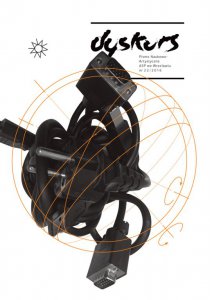Alternative «nows» and «thens» to be
Alternative «nows» and «Thens» to Be
Author(s): Edward A. ShankenSubject(s): Media studies, Visual Arts, Sociology of Art
Published by: Akademia Sztuk Pięknych im. Eugeniusza Gepperta we Wrocławiu
Keywords: Artistic canons; art and science; art and technology; art and ideology; main trends in modern art; media art;
Summary/Abstract: The article was fiirst published [in:] WRO 2011 catalogue, Wro Art Center.I take the theme “alternative now” as being concerned not just with the present but as cutting right to the core of the philosophy of history. Without denying the facility of actual events, the malleability of history is demonstrated by the many ways the canon of art history has been written and rewritten from the perspectives of ever-changing present. Butthis is also a two-way street. Just as every “now” arguably constructs an alternative “then”, so every “then” constructs an alternative “now”.Moreover, every alternative “now” and “then” establishes a particular foundation for imagining the future. This inevitably impacts the “nows”and “thens” to be; those that are yet to come.My scholarship has been deeply concerned with writing and rewriting the history of art. Academic writing in the humanities is predicated on a simple formula: 1) identify a problem; 2) discuss what other people have said about that problem; 3) articulate your own original perspective and argue in support of it. Coming up with an original perspective that is compelling – even just to oneself – can seem like a gift from the gods.Even if so blessed, convincing others that one’s position is worth considering can be an extraordinary challenge, one that is proportional to how far it diverges from the status quo. But this is precisely what is required to influence people; in effect, to alter history.So why bother? Others’ ideas expand my understanding of the world,making my life more meaningful and, well, awesome, in the most literal sense. By creating and sharing ideas I hope to have the same effect on others. My idealism goes even further, for I believe this process helps cultivate a more peaceful world. If we know more, are open to alternative world views, and can understand others’ perspectives, then perhaps we can be more sensitive, tolerant and embracing of others. The more we can embrace other individuals and cultures, the more difficult it becomes to destroy them and the greater our motivation becomes to reconcile our differences in a mutually beneficial way. Although I can find little tangible evidence to support this belief, my commitment to it was reinforced when I heard a very similar position expressed by the former director of the Metropolitan Museum of Art Philippe de Montebello in 2007.In my article, I shall outline some rhetorical strategies which I have employed in my own attempts at rewriting history. A key example from my current research on bridging the gap between mainstream contemporary art and new media art will be elaborated and analyzed in terms of its implications. Finally, I shall raise some provocations regarding the potential significance of particular local histories for informing alternative accounts of the past and present.One of my strategies for historical revision concerns questioning categorical divisions that obscure parallels and continuities. Although it is important to make distinctions, lest everything all be an undifferentiated muddle, distinctions, boundaries, definitions and the like must be scrutinized with respect to their ideology and the violence they do to the people, places and ideas involved. As sociologist Thomas F. Gierynhas written, “Boundary-work is strategic practical action […] Borders and territories […] will be drawn to pursue immediate goals and interests[…] and to appeal to the goals and interests of audiences and stakeholders”. Quoting Pierre Bourdieu, Gieryn further notes that such boundaries constitute “ideological strategies and epistemological positions where by agents […] aim to justify their own position and the strategies they use tomainta in or improve it, while at the same time discrediting the holders of the opposing position and strategies.”
Journal: DYSKURS Pismo Naukowo-Artystyczne ASP we Wrocławiu
- Issue Year: 2017
- Issue No: 1 (22)
- Page Range: 40-54
- Page Count: 15
- Language: English

